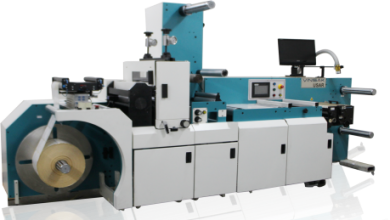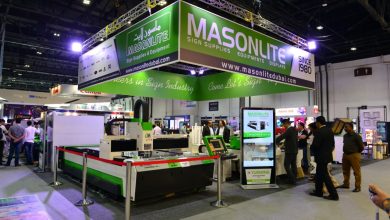Fespa Digital Proves Exhibitions Are Alive
Fespa Digital held between 20 and 23 May 2014 was a successful show by all accounts. visitors streamed to Munich from 121 countries. 70% of visitors came from outside the host nation. ME Printer team of International editors including Alex Jahanbani from UAE, Rod Hayes from UK and Nicholas Hellmuth from US flown to Munich to observe and report on the show.
What a surprising success Fespa Digital at Munich turned out to be and dare it be suggested the success was well beyond the organiser expectations. Visitors flocked to the Munich Messe in considerable numbers, their minds open, inquisitive and hungry to capture information on latest trends and potential money making opportunities, exactly why you would visit a trade show. The show was a success and thanks should be offered to the exhibitors and the quality of the venue.
A good journalist has his ear to the ground constantly listening for murmurings of discontent, gossip and rumour mongering, but alas none were to be heard this time round; all the exhibitors pushed the boat out to the limits of their abilities. Those who needed good electricity supplies received them in abundance, no stand was still being wired up and lighting being connected when the doors were opened. There was an air of ‘practice is over, let the performance begin.’
And what a performance! It would be tedious to mention all the exhibitors piecemeal, rather better to concentrate on a few as being typical of the many. Durst for example is a good place to start.
 Its offerings are at the serious end of the market, very large format, and high speed one pass printers with loads of options. Durst would probably have within its database almost every potential client capable of buying one of its machines whether roll fed or flat sheet and a good idea of where the potential market is for the output of its Rho Series printers being displayed at the show. Durst has the means of contacting these potential clients on a regular basis and also has staff who would be able to show any potential client how best to approach a developing market. This begs the question: ‘Why would the likes of Durst, EFI and Canon bother or even need to come to Fespa Digital?’
Its offerings are at the serious end of the market, very large format, and high speed one pass printers with loads of options. Durst would probably have within its database almost every potential client capable of buying one of its machines whether roll fed or flat sheet and a good idea of where the potential market is for the output of its Rho Series printers being displayed at the show. Durst has the means of contacting these potential clients on a regular basis and also has staff who would be able to show any potential client how best to approach a developing market. This begs the question: ‘Why would the likes of Durst, EFI and Canon bother or even need to come to Fespa Digital?’
There are some very good reasons why it should come and in effect why Durst did. The reprographic community which really means any individual or company with an interest in creating printed material is currently experiencing is a revolution of how print is carried out. A revolution as profound as the one occurring when letterpress and screen printing changed to offset and may be now it is offset turn fade in to digital.
Revolutions are driven by aspirations to improve the quality of life. A manager who starts with an entry level wide format printer aspires to get two of them as his business grows: two machines may mean a better education for his children or a nicer car and so it goes on. Anyone who buys an Océ Canon Arizona 6170 is hardly likely to say to himself: “That’s it, I have arrived. Time to put the feet up and enjoy the profits!”
All the exhibitors showing at Fespa Digital know this as well for they too are driven by the same aspirational forces – long may it be so. What was so rewarding with this show was the ease with which the various facets of the revolution could be seen. The inkjet heads themselves have, via superb software, two way communication built that offers drop on demand technology for anything up to seven or eight levels of increment, along with self-cleaning and the monitoring of individual heads and varieties of ink suitable for printing on any surface, rough or smooth, fabric or plastic.
What would seem astonishing to an outsider is not the technology itself but the way the cognoscenti of the industry sweat on the small things: Is Hewlett Packard likely to sweep the industry off its feet with the perceived leadership in latex inks, is Agfa going to follow or more likely, contest leadership with UV inks? No these are not the issues facing the industry. Wide format printing is far from a one trick pony with a one solution fit for all.
And here is why:
Whether water or solvent is used to carry the pigment the laws of physics will play a major factor on the method is used. The following figures are purely to establish a way of understanding the challenges faced and are not in any way definitive. Latex ink is a comparatively low energy product in the making; nontoxic and very easy to produce and handle and the system is superb for producing pigment shapes that are platelets in shape of a ratio of around three to one – width versus depth. There is little wonder this is a product worth pursuing; not only by HP, but also Xerox, Fujifilm, Mimaki and many others all produce inks and toners having a latex based origin. Little energy is used to produce the ink, but driving the water out requires significant amounts; one litre of water draws 4 kilowatts of energy for 20 minutes to just bring the water to the boil, the potential to destabilise the stock is significant, the laws of physics are visible to the operator.
UV based inks once cured are astonishingly stable with little potential for chemical migration, but handling the key photo initiators require serious health and safety compliance issues, for they are cancerous as is the light spectrum required for their curing. Agfa’s Willy Van Dorm, Marketing Manager Wide Format Inkjet comments: “We are at heart a chemicals manufacturer and we could produce latex ink if we wished, but our skills and manufacturing history background mean that our inks and printing systems produce no side effects capable of being detected.
Agfa is sticking for the foreseeable future to UV, it now has a range of printers that cover most facets of the wide format sector and Van Dorm makes a good metaphor when he says: “Changing or introducing Latex would require us to jump on to a fast moving train, yet there would be little benefit in doing so for our printers and inks are already market leaders.” Those manufacturers of UV inks have to manage the laws of physics by doing the health and safety exercises primarily in the privacy of their own homes.
 The case for solvent raises different issues and its environmental impact is probably more obvious; you can smell it. And if you can smell it is capable of doing you harm. In addition most of the solvents suitable for printing are made from petroleum distillates and while little energy is required to evaporate the solvent, significant energy is required during its manufacture and its subsequent use to capture and render its gaseous form harmless. Here the laws of physics require those who manufacture solvent based inks to establish that it is safe and has been manufactured in an acceptable way.
The case for solvent raises different issues and its environmental impact is probably more obvious; you can smell it. And if you can smell it is capable of doing you harm. In addition most of the solvents suitable for printing are made from petroleum distillates and while little energy is required to evaporate the solvent, significant energy is required during its manufacture and its subsequent use to capture and render its gaseous form harmless. Here the laws of physics require those who manufacture solvent based inks to establish that it is safe and has been manufactured in an acceptable way.
Mimaki makes such claims and does so strongly. It constructs a range of printers that use solvents, UV and at a modest level latex inks (primarily for specialist colours and applications such as white, Orange and green). Mike Horsten general manager, marketing in Europe and the Middle East comes across as a pretty confident individual: “We truly understand that business success in the sign and display graphics business is so much more than simply purchasing equipment, that’s why we devote a significant amount of resources to ensuring that we can offer a complete solution.”
One gets the feeling that Mr. Horsten puts his money where his mouth is: “When it comes to sustainability and finding ways to reduce our impact on the environment we find a lot of businesses make the right noises but are they doing the right things? Sustainable considerations do not just affect the products we manufacture but also how those products are brought to market. We should all look closely at what are we doing with the products and how we strive constantly to make them more environmentally considerate. This is crucial to reducing the impact.” Like Agfa, Mimaki is probably getting to stage where it is difficult to accurately quantify if there are any harmful effects to the environment.
He claims that all activities are now planned and undertaken with the aim of finding the best way to decrease an environmental footprint. The approach is verified at all levels within the group and will continue to be strengthened in the future. Horsten adds: “Terrestrial resources are limited. It is vital the company, its dealers and distributors all embrace an ethos of environmental preservation.”
Everyone will go along with that, but it does imply an assumption that to get a fair, comparative picture of the total impact of any specific application makes on the environment all suppliers and manufacturers need to evaluate their products in a similar way. The US and Europe are well on the way to having a methodology to ensure the environmental issues are addressed, but there is still way to go before another important issue is resolved – the one Horsten intimated when he said that the terrestrial resources are limited and that is how to completely recycle or return to the natural environment after the useful life of a piece of equipment has ended. This is possibly the greatest challenge now facing the wide format brigade.
There is another vexatious issue that dogs the industry and that is the question of third party ink manufacturing and supply. A machine manufacturer builds his machine and the inks as if it is a complimentary exercise; it sees it as a single manufacturing unit. Their position naturally enough is why should the life of the machine be prejudiced, risk the potential of print – simply to possibly save a few bucks? Of course the contra argument is that manufacturers are ripping off its client by excessive charging for what is a fairly simple chemical product and are using coercive force by withdrawing warranties if third party inks are being used.
Difficult to take sides on that one; too many cards are being held too close to the chest; if a buyer invests in a new machine and doesn’t use the proprietary ink during the warranty period of the purchase, this is little different to a man who buys a wonderfully flash and powerful motorbike but then buys the cheapest crash helmet possible to put his head in. However given the shelf life of many wide format printers, particularly those priced at the entry level, is rarely more than 2-3 years before their performance and productivity levels are superseded the decision as to what inks to use then becomes more opaque.
Contentious issues such as these made a visit to Fespa Digital immensely rewarding; there was an openness by the exhibitors both to the design of their stands and the manner in which visitors were treated with respect. There was an awareness of how well the visitor was informed and knowledgeable of his needs and business strategies. The evidence for suggesting this was how crowded and bustling the stands that were demonstrating products complimentary to core wide format printing. The numerous third party ink manufacturers and media suppliers enjoyed good footfalls, but it seemed that flat-bed cutting systems excited outstanding interest. Visiting stands such as the Océ Canon Arizona, the Kongsberg range was a little like trying to get in to a cup final match.
Why? The question worth asking and the answer is pretty obvious. Already with wide format printing the print is beginning to follow the trend well established that the print isn’t where most of the profit comes, what is done before and after the print where the real value added lies. The more innovative a printing house is in the services he offers, the more likely he is to capture a client and of equal importance – keep him.
 It seems a little unfair to pull one manufacturer out of a high quality pack but, the Swiss manufacturer has caught the direction the industry is moving perfectly: Stefan Lang head of marketing says “Our primary focus has been on increasing efficiency throughout the production workflow. We can now demonstrate cutting system configurations that meet rigorous productivity demands now typical of those encountered on a daily basis by most print service providers. The software and hardware components allow fully-automated material handling systems that limit the need for manual intervention.”
It seems a little unfair to pull one manufacturer out of a high quality pack but, the Swiss manufacturer has caught the direction the industry is moving perfectly: Stefan Lang head of marketing says “Our primary focus has been on increasing efficiency throughout the production workflow. We can now demonstrate cutting system configurations that meet rigorous productivity demands now typical of those encountered on a daily basis by most print service providers. The software and hardware components allow fully-automated material handling systems that limit the need for manual intervention.”
Nicely put, but behind these words is a wealth of innovation visible all across Fespa Digital. The implementation of small servo motors integrated with software though proprietary to a certain extent, depends heavily on widely available logic chips and so allowing almost every mechanical action from picking up sheets and pre-cut shapes and then individually cutting them in a preprogrammed order with final delivery to a dedicated zone. The smart bit is all this is carried out without human intervention.
This is not robotics in action where the same action is carried out over and over again, but genuine pre-programming; individual actions taking place sequentially perhaps only once, perhaps many times, essentially there is a choice. What we are seeing coming to flatbed cutting is the same sort of actions that happened in transactional printing some years ago; each sheet being individually personalised.
Given what is happening in the flat bed sector, perhaps Mr. Lang could have the last word (or words!): “There is a printer in Switzerland who has ten of these machines (the G3 M-2500 tandem cutting system) in one room and all of the machines operated by one man.”
But he isn’t getting the last word: His comments drew a stark mental picture of a poor soul beavering away, never to see humanity again, but sustained by a small lump of bread and a glass of fetid water being passed through a small hatch. Is this the future of print? Let’s hope not.

.gif)



